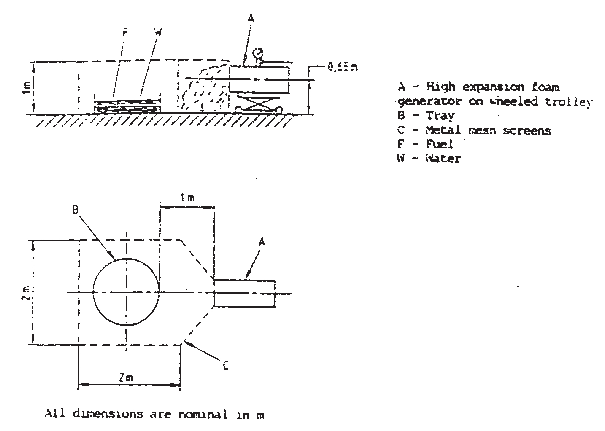Fire tests should be carried out according to the following
paragraphs 3.8.1 to 3.8.7.
Note The fire tests of section 3.8 are more expensive and time
consuming than the other tests of these guidelines. It is recommended
that fire tests should be carried out at the end of the test programme,
so as to avoid expense of unnecessary testing of foam concentrates
which do not comply in other respects.
3.8.1 Environmental conditions
| - Air
temperature
|
: (15 +
5)°C
|
| - Maximum
wind speed
|
: 3 m/s in
proximity of the fire tray
|
3.8.2 Records
During the fire test, record the following:
- indoor or outdoor test
- air temperature
- fuel temperature
- water temperature
- foam solution temperature
- wind speed
- extinction time.
3.8.3 Foam solution
-
(a) Prepare a foam solution, following the recommendations
from the supplier for concentration, maximum premix time, compatibility
with the test equipment, avoiding contamination by other types of
foam, etc.
-
(b) The test should be carried out with sea water
at about 20°C. Simulated sea water with the characteristics stated
in 3.6.3 may be used.
3.8.4 Apparatus
-
(a) Fire tray:
Circular fire tray of steel with dimensions as follows:
| diameter at rim
|
:
(1,480 ± 15) mm
|
| depth
|
: (150
± 10) mm
|
| nominal thickness of steel wall
|
: 2.5
mm
|
-
NOTE: The tray has an area of approximately 1.73 m2
-
(b) Foam-making equipment:
In accordance with subparagraph 3.6.2(a).
-
(c) Fire screens:
Fire screens of nominal 5 mm square metal mesh to form the nominal
arrangement mentioned in subparagraph 3.8.6.
3.8.5 Fuel
Use an aliphatic hydrocarbon mixture with physical properties
according to the following specification:
| -
distillation range
|
:
84°C-105°C
|
| - maximum
difference between initial and final boiling points
|
:
10°C
|
| - maximum
aromatic content
|
: 1%
|
| - density
at 15°C
|
: (707.5 +
2.5) kg/m3
|
| -
temperature
|
: about
20°C
|
The Administration may require additional fire tests using an
additional test fuel.
3.8.6 Test procedure
-
(a) Place the tray directly on the ground and
ensure that it is level. Add approximately 30 litres of sea water,
or simulated sea water with the characteristics stated in 3.6.3, and (55 ± 5) litres of
fuel, to give a nominal freeboard of 100 mm.
-
(b) Place the net screens around the fire tray
as shown in Figure 2. Within
5 min ignite the fuel and allow it to burn for a period of not less
than 45 s. Commence foam generation with the foam generator some distance
from the fire.
(60 ± 5) s after full involvement move the foam generator
to the opening between the net screen and apply foam to the fire.
Apply foam for a period of (120 ± 2) s. Record the extinction
time as the period from start of foam application to extinction.

Figure 2 Fire test arrangement
3.8.7 Permissible limits
extinction time: not more than 120 s